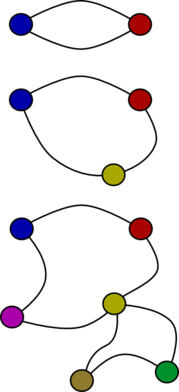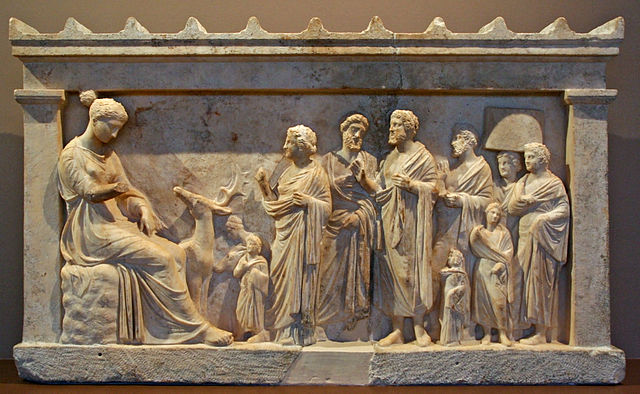15.9. Fuzzy degeneracy¶
15.9.1. How the path finder works¶
Given a list of atomic coordinates for a cluster of atoms, multiple scattering paths can be found from those atoms.
A heap is a tree-shaped data structure. Each node is guaranteed to represent a shorter path length than all nodes below it. The top node is, thus, guaranteed to be the shortest path. For more details, see
- S. I. Zabinsky, J. J. Rehr, A. Ankudinov, R. C. Albers, and M. J. Eller. Multiple-scattering calculations of x-ray-absorption spectra. Phys. Rev. B, 52:2995–3009, Jul 1995. doi:10.1103/PhysRevB.52.2995.
- Find all paths (0 i 0), i ≠ 0 in the cluster. These paths are represented by the two-leg diagram in Fig. 15.32. Put each such path in a heap.
- For each such path, add a leg with j ≠ i and j ≠ 0. Put all (0 i j 0) in the heap. These paths are represented by the three-leg diagram in Fig. 15.32.
- Up to some order of scattering, populate the heap with (0 i ... x 0)
- Test each path (0 i ... x 0) for magnitude. If small, discard and do not consider any (0 i ... x y 0)
- Use up all atoms in the cluster and up to some order of scattering (FEFF's default is 7 legs).
Construct the path list by repeatedly pulling the top path from the heap until the heap is empty. When the top node is removed, the remaining nodes rearrange themselves such that heap retains the property that each node represents a shorter path than all those below it.
The resulting path list is guaranteed to be sorted by increasing path length. The list is then examined to find “degenerate” paths. Degenerate paths are ones that contribute identically to the EXAFS. A simple example would be the single scattering paths from the various atoms in the first coordination shell. Since each atom is the same distance away from the absorber, each contributes identically to the EXAFS. Thus these paths are degenerate. After being screened for degeneracy, the path list is presented to the user.
15.9.2. The pathfinder in Feff and Artemis¶
One of the features of ARTEMIS is a rewrite of FEFF's pathfinder.
The new path finder has two huge advantages over FEFF's:
- User configurable fuzzy degeneracy. FEFF considers paths that differ in length by 0.00001 Å to be non-degenerate. ARTEMIS can group together these nearly degenerate paths.
- The scattering geometries of the degenerate paths are stored and are available for use and examination. FEFF discards the details of the degenerate paths.
The first point – the use of fuzzy degeneracy – is the topic of this section.
FEFF's path finder, however, has its advantages over ARTEMIS':
- As it is written in a compiled language, it is considerably faster. Fortunately, the path finder does not need to be run very often.
- FEFF uses its fast plane wave calculation to approximate the importance of path. Low importance paths can be removed from consideration, as can all higher order paths built from that path. ARTEMIS does not have access to the plane wave calculation, so it must consider rather more paths than FEFF's pathfinder. ARTEMIS relies instead on some simple heuristics to trim the tree of paths.
- FEFF's path finder considers up to seven-legged paths. ARTEMIS can do five- and six-legged paths, but it is slow. In any case, it is rather unusual to need more than four-legged paths in an EXAFS analysis. (Cubic metals analyzed beyond about 6 Å and cyanide bridged structures like prussian blue are two examples.)
Todo
ARTEMIS' path finder does not currently handle ellipticity. So that's another advantage at the moment for FEFF's path finder.
15.9.3. An example of using fuzzy degeneracy¶
As the path finder organizes all the scattering geometries it finds among the atoms in the input atoms list, it will make a fuzzy comparison to sort the paths into nearly-degenerate bins. That is, all paths whose lengths are within a small margin will be considered degenerate. The width of this bin is set by the ♦Pathfinder→fuzz preference.
Consider this feff.inp file (made from this crystal data):
TITLE magnetoplumbite PbFe_12O_19
HOLE 4 1.0 * FYI: (Pb L3 edge @ 13035 eV, second number is S0^2)
* mphase,mpath,mfeff,mchi
CONTROL 1 1 1 1
PRINT 1 0 0 0
RMAX 5.0
*NLEG 4
POTENTIALS
* ipot Z tag
0 82 Pb
1 82 Pb
2 26 Fe
3 8 O
ATOMS * this list contains 84 atoms
* x y z ipot tag distance
0.00000 0.00000 0.00000 0 Pb1 0.00000
1.65468 0.00003 2.30070 3 O.1 2.83394
-0.82737 -1.43298 2.30070 3 O.1 2.83394
1.65468 0.00003 -2.30070 3 O.1 2.83394
-0.82737 -1.43298 -2.30070 3 O.1 2.83394
-0.82737 1.43304 2.30070 3 O.1 2.83397
-0.82737 1.43304 -2.30070 3 O.1 2.83397
2.63123 -1.31552 0.00000 3 O.2 2.94176
-0.17634 -2.93647 0.00000 3 O.2 2.94176
2.63123 1.31558 0.00000 3 O.2 2.94179
-2.45494 -1.62092 0.00000 3 O.2 2.94179
-2.45494 1.62098 0.00000 3 O.2 2.94182
-0.17634 2.93653 0.00000 3 O.2 2.94182
1.69537 -2.93647 0.00000 2 Fe2.1 3.39074
-3.39080 0.00003 0.00000 2 Fe2.1 3.39079
1.69537 2.93653 0.00000 2 Fe2.1 3.39079
0.83581 -1.44767 3.24399 2 Fe5.1 3.64935
0.83581 -1.44767 -3.24399 2 Fe5.1 3.64935
-1.67167 0.00003 3.24399 2 Fe5.1 3.64937
0.83581 1.44772 3.24399 2 Fe5.1 3.64937
-1.67167 0.00003 -3.24399 2 Fe5.1 3.64937
0.83581 1.44772 -3.24399 2 Fe5.1 3.64937
3.39074 0.00006 1.38042 2 Fe4.1 3.66097
-1.69542 -2.93644 1.38042 2 Fe4.1 3.66097
3.39074 0.00006 -1.38042 2 Fe4.1 3.66097
-1.69542 -2.93644 -1.38042 2 Fe4.1 3.66097
-1.69542 2.93656 1.38042 2 Fe4.1 3.66107
-1.69542 2.93656 -1.38042 2 Fe4.1 3.66107
... (more atoms follow)
END
Using the default ♦Pathfinder→fuzz parameter of 0.03
Å, will give these paths. Note that the Fe4 and Fe5
scatterers, which differ by about 0.11 Å, get merged into a single
scattering path. This path has a value of Reff that is the
average of the constituent paths and a degenaracy that is the sum of
the constituent paths.
# degen Reff scattering path I Rank legs type
0001 6 2.834 ---- @ O.1 @ 2 100.00 2 single scattering
0002 6 2.942 ---- @ O.2 @ 2 89.88 2 single scattering
0003 3 3.391 ---- @ Fe2.1 @ 2 34.83 2 single scattering
0004 12 3.655 ---- @ Fe5.1 @ 2 100.00 2 single scattering
Resetting the ♦Pathfinder→fuzz to 0.01 separates those two nearly degenerate paths into separate scattering paths.
# degen Reff scattering path I Rank legs type
0001 6 2.834 ---- @ O.1 @ 2 100.00 2 single scattering
0002 6 2.942 ---- @ O.2 @ 2 89.88 2 single scattering
0003 3 3.391 ---- @ Fe2.1 @ 2 34.83 2 single scattering
0004 6 3.649 ---- @ Fe5.1 @ 2 57.63 2 single scattering
0005 6 3.661 ---- @ Fe4.1 @ 2 57.15 2 single scattering
To make the pathfinder neglect fuzzy degeneracy, thus behaving like FEFF's pathfinder, set ♦Pathfinder→fuzz to 0.
Fuzzy degeneracy is discussed in
- B. Ravel. Path degeneracy and EXAFS analysis of disordered materials. Journal of Synchrotron Radiation, 21(6):1269–1274, Nov 2014. doi:10.1107/S1600577514014982.
DEMETER is copyright © 2009-2016 Bruce Ravel – This document is copyright © 2016 Bruce Ravel
This document is licensed under The Creative Commons Attribution-ShareAlike License.
If DEMETER and this document are useful to you, please consider supporting The Creative Commons.


